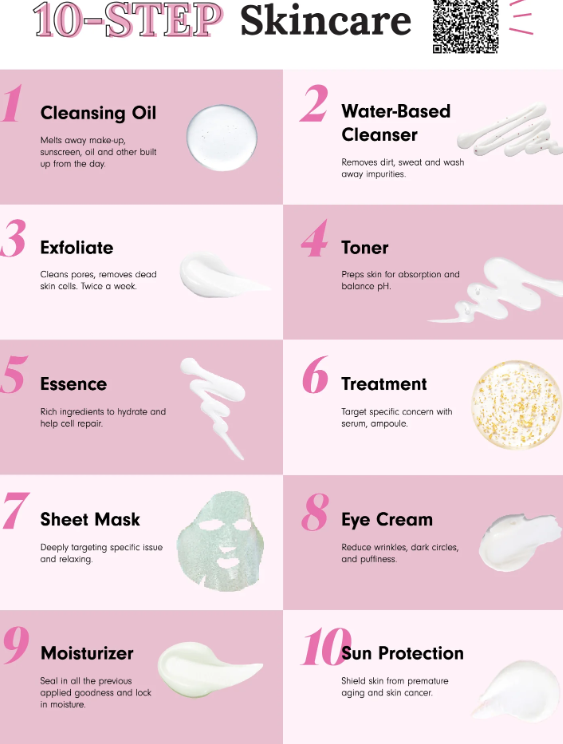BOURSESSENEGAL – Creating an effective skin care routine can feel overwhelming, especially with the plethora of products and advice available. However, understanding the fundamentals of a skin care routine can lead to radiant, healthy skin. In this guide, we’ll break down the essential steps and considerations you need to develop a personalized skin care routine that works for you.
Understanding Your Skin Type
Before diving into the specifics of a skin care routine, you need to identify your skin type. Knowing whether you have oily, dry, combination, sensitive, or normal skin will help you choose products that cater to your specific needs.
Oily Skin
If you often experience shine, especially in the T-zone (forehead, nose, and chin), you likely have oily skin. This skin type may benefit from lightweight, oil-free products that help control excess oil without stripping your skin.
Dry Skin
If your skin feels tight, flaky, or rough, you may have dry skin. Look for hydrating products that contain ingredients like hyaluronic acid and ceramides, which can help restore moisture and improve skin texture.
Combination Skin
Combination skin features a mix of dry and oily areas. Typically, the T-zone is oily while the cheeks remain dry. A balanced approach works best, using products suited for each specific area.
Sensitive Skin
Sensitive skin can react to various products, causing redness or irritation. Choose gentle, fragrance-free formulations that minimize the risk of irritation.
The Essential Steps in Your Skin Care Routine
Now that you understand your skin type, let’s explore the essential steps of a skin care routine.
1. Cleansing: The Foundation of a Skin Care Routine
Cleansing is the first and crucial step in any skin care routine. It removes dirt, oil, and makeup that can clog pores and lead to breakouts. Choose a gentle cleanser that suits your skin type.
- For Oily Skin: Consider foaming or gel cleansers that can help reduce shine.
- For Dry Skin: Creamy or hydrating cleansers work best, providing moisture while cleansing.
- For Combination or Sensitive Skin: Use a mild, sulfate-free cleanser that balances your skin’s needs.
2. Toning: Refining Your Skin Texture
Toners can be a beneficial addition to your skin care routine. They help remove any residual impurities after cleansing and prepare your skin for the next steps.
- Astringent Toners: Ideal for oily skin, they help minimize pores and control oil.
- Hydrating Toners: Look for alcohol-free options packed with antioxidants for dry or sensitive skin types.
3. Exfoliation: Renewing Your Skin
Exfoliation helps remove dead skin cells, revealing fresh, glowing skin beneath. However, it’s essential not to over-exfoliate, as this can lead to irritation.
- Physical Exfoliants: Scrubs that manually buff away dead skin can be effective but should be used sparingly.
- Chemical Exfoliants: Alpha hydroxy acids (AHAs) and beta hydroxy acids (BHAs) provide gentle exfoliation, suitable for various skin types.
Tip: Incorporate exfoliation into your routine 1-2 times a week for best results.
4. Moisturizing: Hydration is Key
Moisturizing helps maintain your skin’s hydration levels, preventing dryness and improving texture. Select a moisturizer based on your skin type:
- Lightweight Gel Creams: Great for oily skin, they hydrate without adding excess oil.
- Rich Creams or Ointments: Ideal for dry skin, they lock in moisture and provide a protective barrier.
5. Sun Protection: Essential for Healthy Skin
Never skip sunscreen! Protecting your skin from harmful UV rays is vital in preventing premature aging and skin damage.
- Broad-Spectrum SPF: Look for products that protect against both UVA and UVB rays.
- Daily Application: Apply sunscreen every morning, even on cloudy days.
Additional Steps for Targeted Care
In addition to the basic steps, you might want to incorporate specific treatments into your skin care routine.
Serums: Boosting Your Routine
Serums are concentrated formulations designed to target specific concerns, such as wrinkles, dark spots, or acne.
- Vitamin C Serums: Brighten and even skin tone.
- Retinol: A powerful anti-aging ingredient that promotes cell turnover.
- Hyaluronic Acid: Provides intense hydration and plumps the skin.
Masks: Pampering Your Skin
Facial masks can offer additional benefits and are an excellent way to treat your skin weekly.
- Clay Masks: Help draw out impurities for oily skin types.
- Hydrating Masks: Offer a moisture boost for dry skin.
Crafting Your Personalized Skin Care Routine
Now that you understand the essential steps and products, it’s time to put it all together. Here’s a sample skin care routine tailored for different skin types:
Sample Routine for Oily Skin
- Cleanser: Gel or foaming cleanser
- Toner: Astringent toner
- Exfoliator: 1-2 times a week (chemical exfoliant)
- Serum: Lightweight, oil-free serum (like niacinamide)
- Moisturizer: Oil-free moisturizer
- Sunscreen: Broad-spectrum SPF 30 or higher
Routine for Dry Skin
- Cleanser: Creamy hydrating cleanser
- Toner: Hydrating toner
- Exfoliator: 1-2 times a week (gentle physical exfoliant)
- Serum: Hydrating serum (like hyaluronic acid)
- Moisturizer: Rich, creamy moisturizer
- Sunscreen: Broad-spectrum SPF 30 or higher
Sample Routine for Combination/Sensitive Skin
- Cleanser: Mild, sulfate-free cleanser
- Toner: Alcohol-free hydrating toner
- Exfoliator: 1-2 times a week (gentle chemical exfoliant)
- Serum: Soothing serum (like chamomile or calendula)
- Moisturizer: Balanced moisturizer
- Sunscreen: Broad-spectrum SPF 30 or higher
Final Thoughts
Establishing a skin care routine is an essential part of maintaining healthy skin. By understanding your skin type and choosing the right products, you can create a regimen that suits your unique needs. Remember, consistency is key! Give your routine time to show results, and don’t hesitate to adjust it based on how your skin responds.
Investing in your skin is investing in yourself. With a little patience and dedication, you’ll achieve the glowing skin you’ve always desired. Start today, and embrace the journey to healthier skin!
REFERENCE : https://www.health.com/



